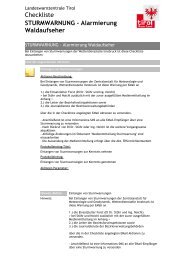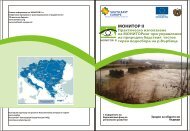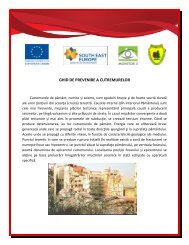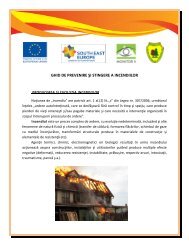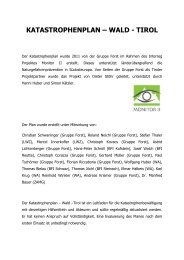risk management - monitor ii
risk management - monitor ii
risk management - monitor ii
You also want an ePaper? Increase the reach of your titles
YUMPU automatically turns print PDFs into web optimized ePapers that Google loves.
8 Monitor II Risk <strong>management</strong> introduction<br />
Monitor II Risk <strong>management</strong> introduction 9<br />
The basic phases of disaster <strong>management</strong><br />
are defined by their temporal relation to the<br />
occurance of hazard events:<br />
Establish the<br />
Context<br />
Figure 3: Strategies of <strong>risk</strong> treatment (S. KOLLARITS et al. 2007)<br />
Preparedness<br />
Preparedness is the phase of planning activities<br />
with a long-term view on <strong>risk</strong> <strong>management</strong>.<br />
Activities within this phase aim at the reduction<br />
of vulnerability (to negative consequences from<br />
hazardous events) and at the reduction<br />
of hazard potential and exposure to hazards.<br />
WISNER et al. (2003²) have defined vulnerability<br />
as being dependent (inversely) on<br />
• the capacity to anticipate<br />
• the capacity to cope with<br />
• the capacity to resist and<br />
• the capacity to recover from<br />
an extreme event.<br />
Response<br />
Response is the phase of reaction to an<br />
ongoing or impeding (potentially) disaster<br />
event with a short-term view on <strong>risk</strong><br />
<strong>management</strong>. Activities within this phase relate<br />
to the emergency operation during the impact<br />
of a disaster and the short-term aftermath.<br />
The main emphasis is on the saving of human<br />
life but it also encompasses the protection of<br />
assets, the supply of vital goods and services,<br />
and protection of environment.<br />
Hazard<br />
Identification &<br />
Characterisation<br />
Risk (components)<br />
analysis<br />
Risk evaluation<br />
Risk treatment<br />
Figure 5: Risk <strong>management</strong><br />
overview (adapted from<br />
Australian/New Zealand<br />
Standard on Risk Management).<br />
Situations<br />
and Measures<br />
The identification and assessment of situations<br />
is a primary prerequisiste in <strong>risk</strong> <strong>management</strong>.<br />
In all phases of <strong>risk</strong> <strong>management</strong> situations<br />
have to be assessed with a maximum of<br />
reliability in order to identify the appropriate<br />
measures for <strong>risk</strong> <strong>management</strong>.<br />
Situations are social objects, which are the<br />
setting for at least one event. Situations<br />
provide the link for both social regulations<br />
(norms) as well as for actions (measures).<br />
Social norms aim at regulating situations, while<br />
measures are directly linked to situations.<br />
Measures can be permanent even if the goal<br />
has been achieved. Measures have a goal as<br />
part and define roles and tasks necessary to<br />
reach the goal.<br />
A scenario can be seen as a pre-defined course<br />
of situations, so measures can be attached<br />
to scenarios as well. The main scenarios and<br />
measure alternatives within <strong>risk</strong> <strong>management</strong><br />
are described in figure 6 below.<br />
Within <strong>risk</strong> <strong>management</strong> situations can<br />
be categorized broadly into general <strong>risk</strong> related<br />
situations and those situations, where<br />
predefined measures can be attached (action<br />
related situations).<br />
Figure 4: Risk <strong>management</strong> cycle (adapted from PLANALP)<br />
Recovery<br />
Recovery is the phase of restoring the affected<br />
area to its previous state, in terms of conditions<br />
of life, infrastructure, communication and<br />
social organisation. Activities related to recovery<br />
phase primarily involve rebuilding destroyed<br />
property, re-employment, and the repair of<br />
other essential infrastructure.<br />
Within each phase of <strong>risk</strong> <strong>management</strong> –<br />
and actually within almost each activity of <strong>risk</strong><br />
<strong>management</strong> – a process from <strong>risk</strong> screening<br />
to <strong>risk</strong> <strong>risk</strong> treatment is being carried out.<br />
Figure 6: Linking <strong>risk</strong> and emergency terms (A. CORSINI)<br />
on terms<br />
A situation describes the<br />
perceived part of reality which is<br />
the basis for action.<br />
Measure is the final (eventlike)<br />
plan, which is oriented<br />
specifically at providing solutions<br />
for one known problem situation.



